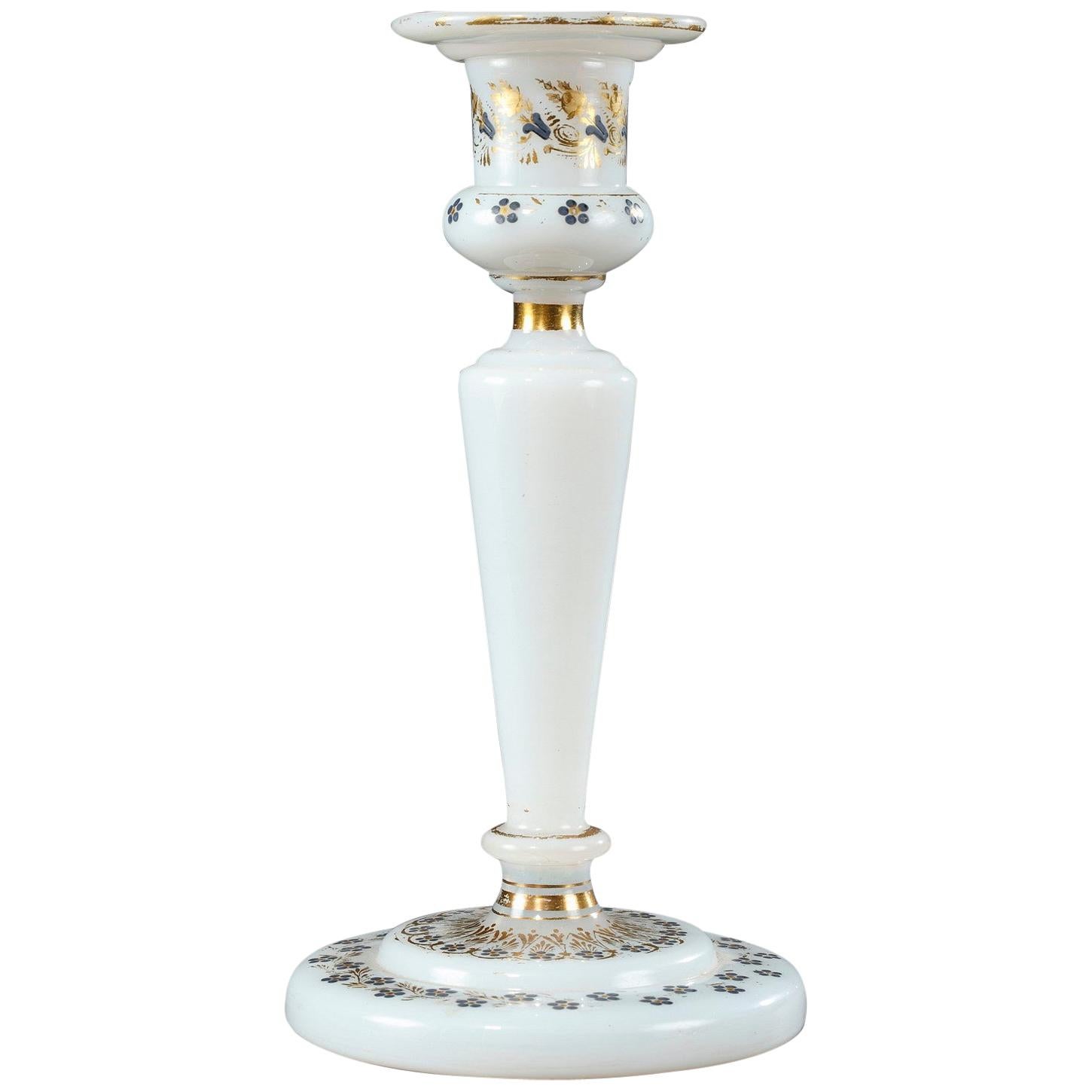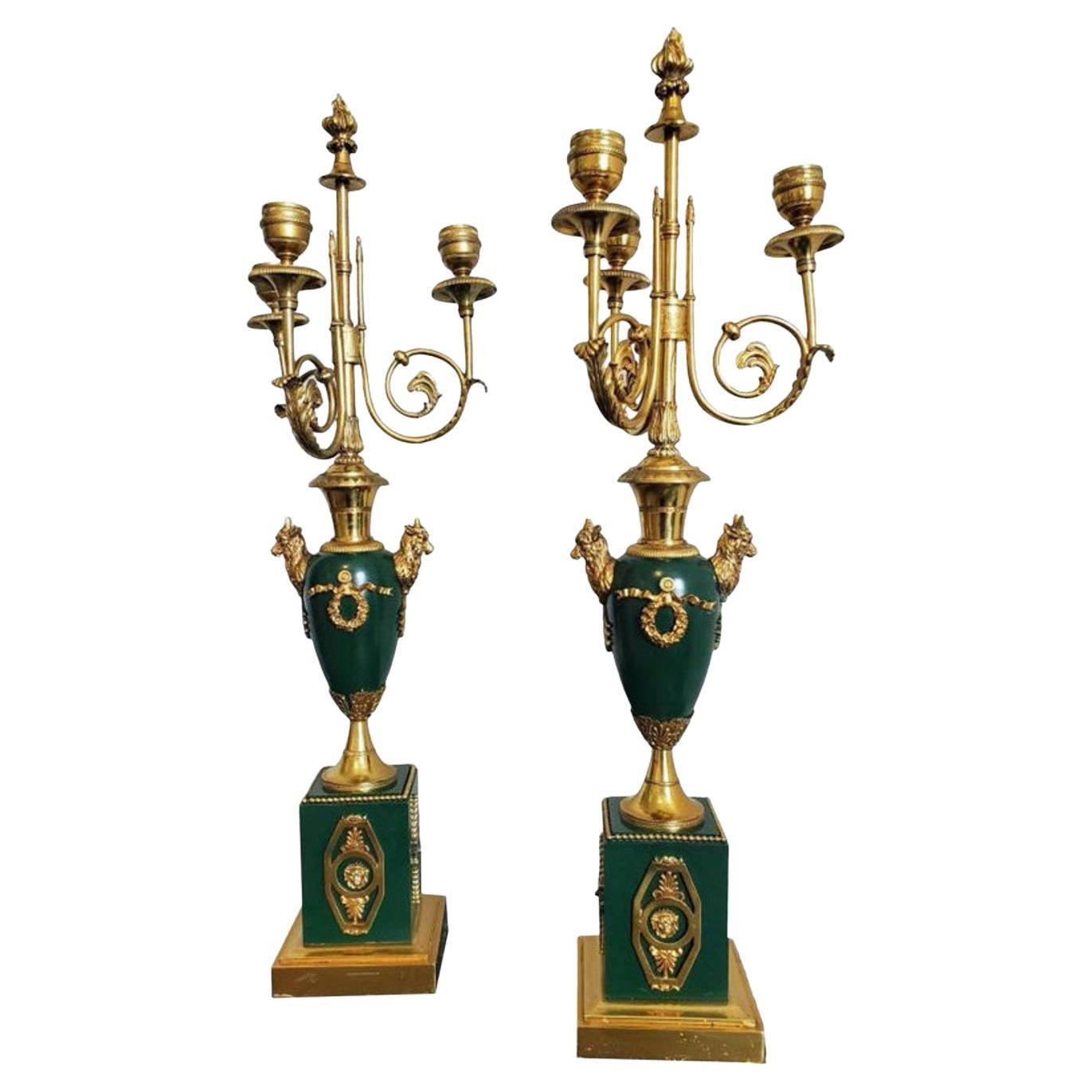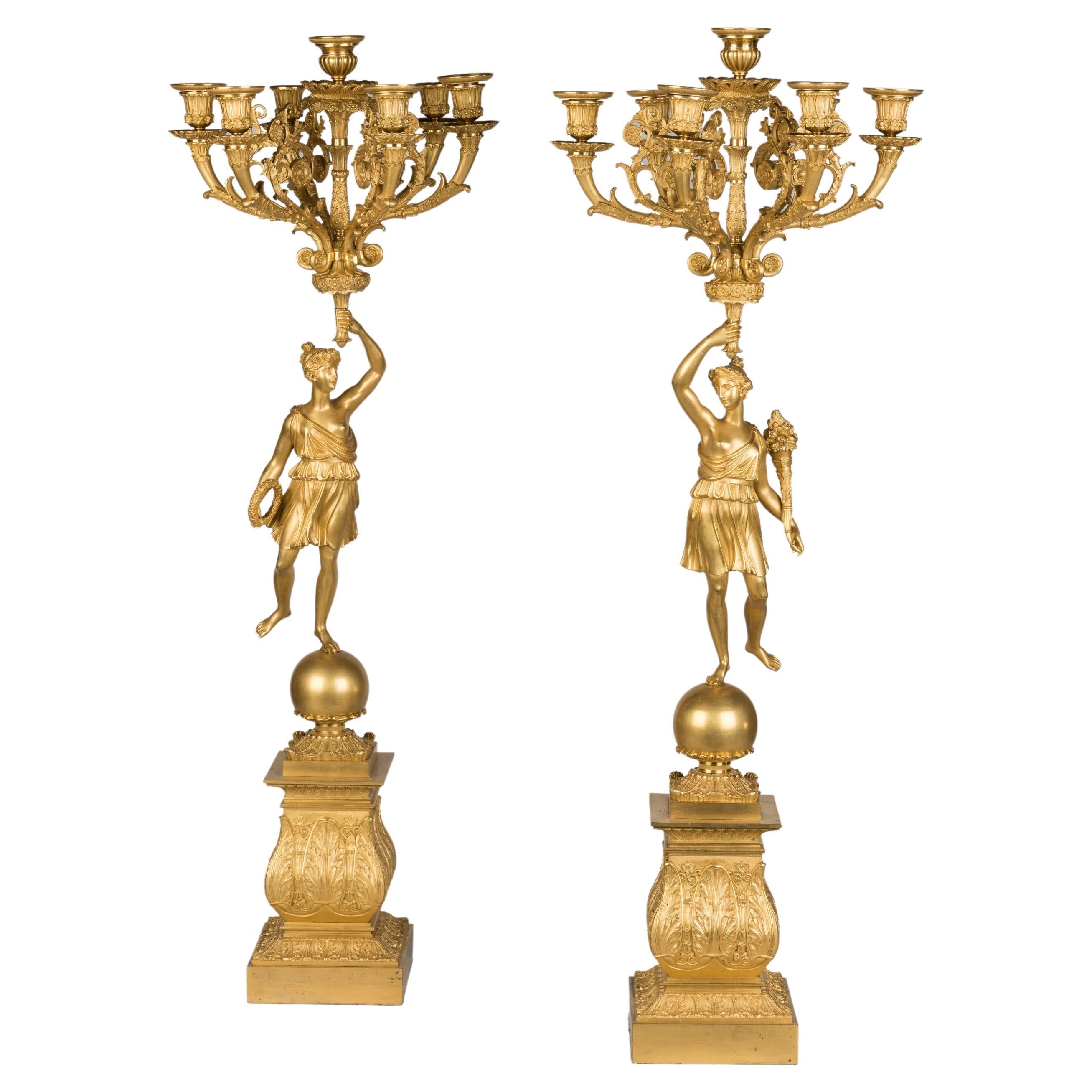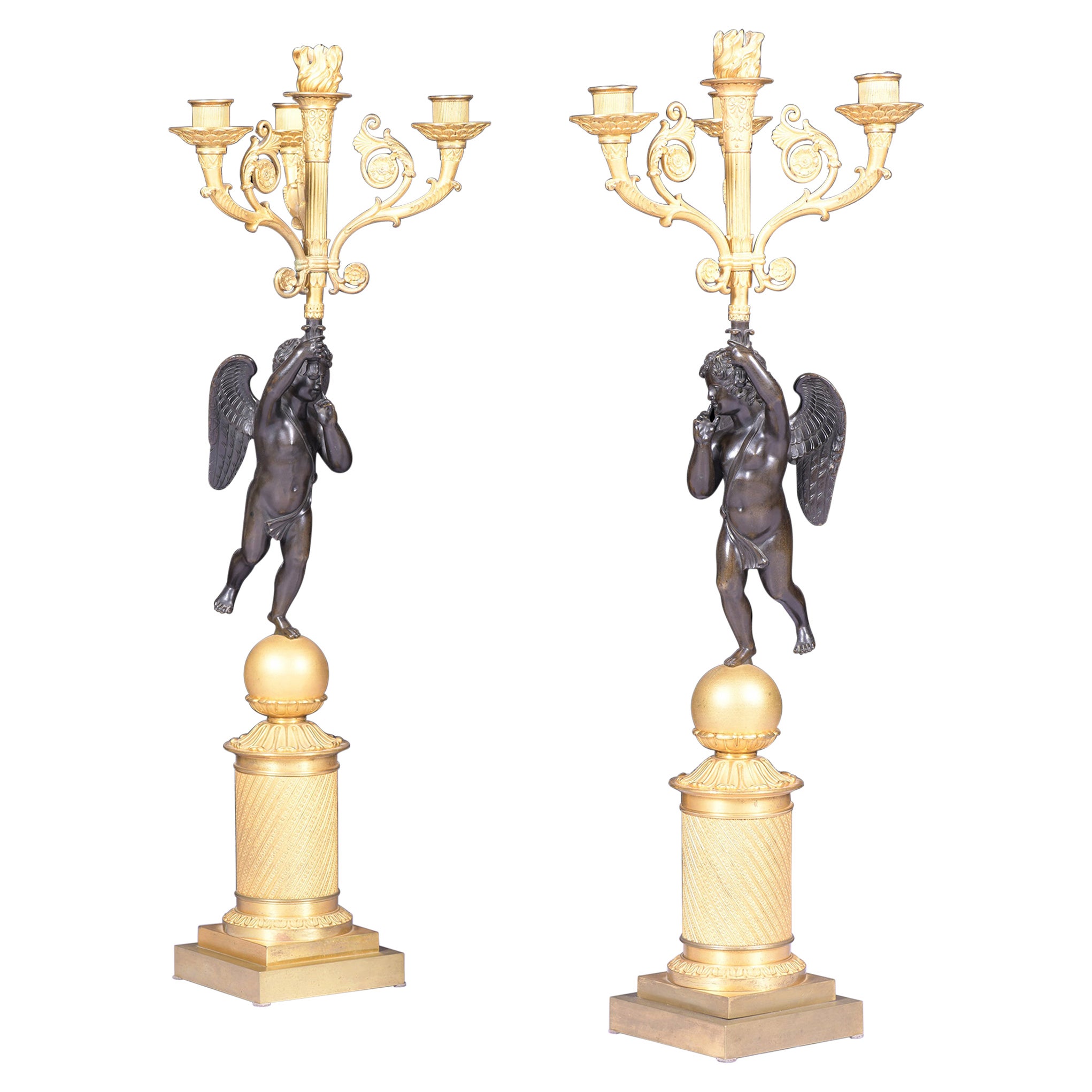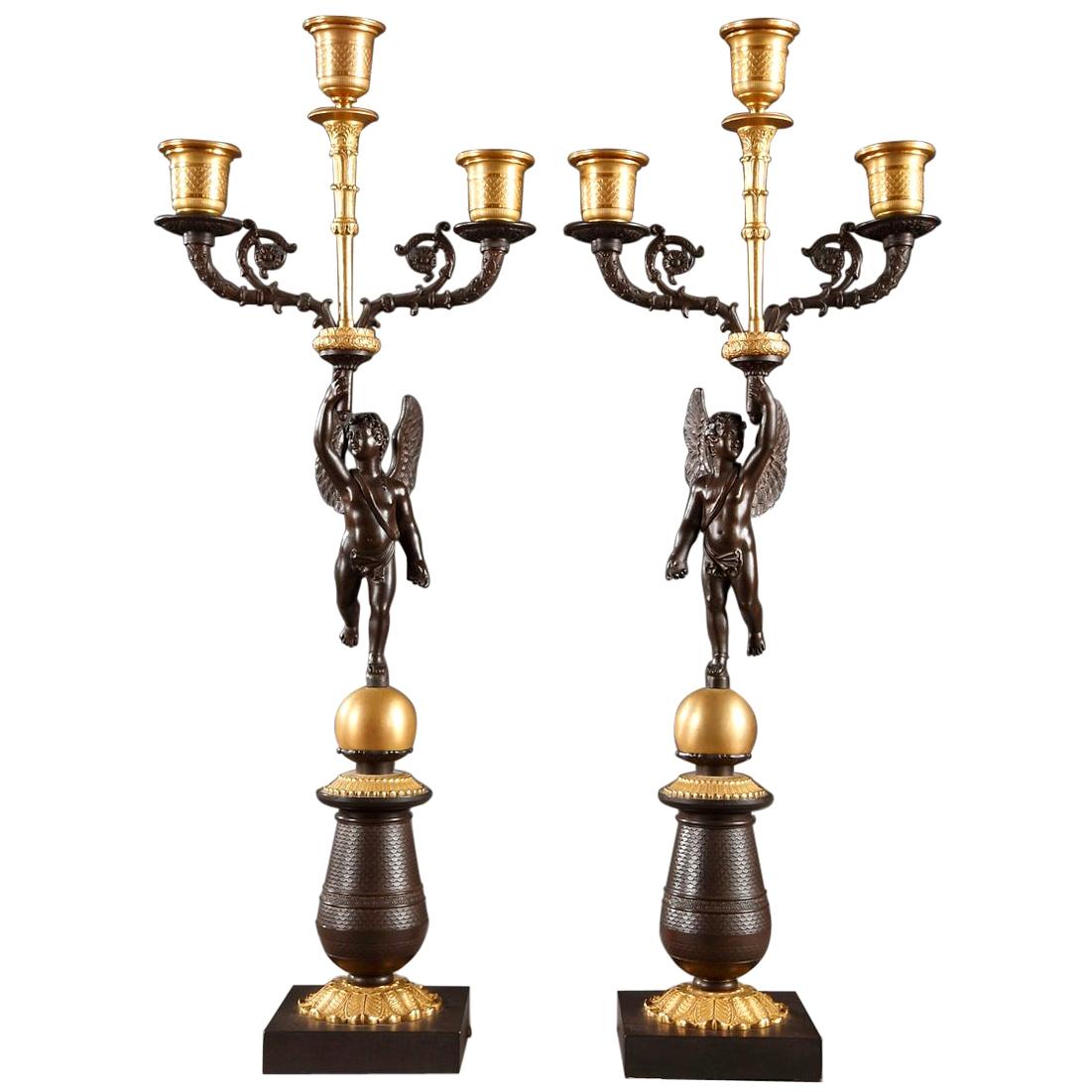Items Similar to Pair of Quinquet, White Opaline, Maison Baccarat, Period: Early 19th Century
Want more images or videos?
Request additional images or videos from the seller
1 of 7
Pair of Quinquet, White Opaline, Maison Baccarat, Period: Early 19th Century
About the Item
Superb pair of "quinquets" or oil lamps from Baccarat.
The foot which acts as a reservoir is cylindrical in white opaline called "ball".
The gilt bronze collar supports an original white opaline globe set with a brass border on the top and bottom.
Each opaline is highlighted by floral motifs and gilded acanthus leaves.
The tubes are made of glass.
Period: Early 19th century - Louis Philippe - Charles X
Dimensions : Total height with glass : 32cm - Globe diameter : 12cm
Diameter of the base : 11cm
Do you know where the name "Quinquet" comes from?
The invention of the oil lamp goes back to the dawn of time, but it made significant progress from 1780 onwards.
The chemist Proust invented the side-tank oil lamp (1780).
This was a major advance, since the oil was higher than the spout and was pushed in by its own weight.
Then Argand invented the cylindrical wick, and the sheet metal chimney, then the glass chimney (1782).
And it was a pharmacist, Antoine Quinquet, who took up these inventions to create a well-developed lamp mounted on a rod (1784), which remained in common use until the arrival of the paraffin lamp (1853).
It was so widely used that the name of its inventor became a common name: a quinquet!
- Dimensions:Height: 12.6 in (32 cm)Diameter: 4.34 in (11 cm)
- Sold As:Set of 2
- Style:Restauration (In the Style Of)
- Materials and Techniques:Opal
- Place of Origin:
- Period:
- Date of Manufacture:19th Century
- Condition:
- Seller Location:CRÉTEIL, FR
- Reference Number:1stDibs: LU7814234714012
About the Seller
4.0
Vetted Seller
These experienced sellers undergo a comprehensive evaluation by our team of in-house experts.
1stDibs seller since 2022
9 sales on 1stDibs
Typical response time: Several days
- ShippingRetrieving quote...Ships From: CRÉTEIL, France
- Return PolicyA return for this item may be initiated within 14 days of delivery.
More From This SellerView All
- Pair of Gilt Bronze Candlesticks Attributed to F.Barbedienne Period 19th CenturyBy Ferdinand BarbedienneLocated in CRÉTEIL, FRLovely pair of gilt bronze candlesticks, attributed to Ferdinand Barbedienne. The tripod base in the shape of lions' paws is surmounted by a collar formed of aquatic vegetation where a salamander wanders. On the fluted, elegant and straight was another salamander hastens to find its congener. The shoulder supporting the four light arms in the shape of an oil lamp is highlighted by three African elephant heads. The sockets are original and removable. A magnificent fantastic creature, guardian of this royal and symbolic fauna, half man, half animal, serving as an extinguisher, comes to magnify the whole of this sublime achievement of quality in all respects. Period: Late 19th century Dimensions: Total height: 55.5cm x width: 16cm The elephant is often seen as a symbol of strength and power. Being a large and magnificent animal, it is quite logically considered a powerful and majestic creature. His way of life, dependent on the herd, is at the origin of deep relational bonds based on loyalty, which develop the power and the will to defend others. The salamander had an amazing reputation for walking through flames. This alleged power has earned him, among other things, to be a royal symbol. With this exceptional power, the salamander was chosen by one of our most flamboyant kings, François 1er...Category
Antique 19th Century Napoleon III Candlesticks
MaterialsBronze
- Candlestick in Gilt Bronze with Snuffer, Louis XVI Style, Period 19th CenturyLocated in CRÉTEIL, FRLovely candlestick in chiseled bronze and gilded with mercury. Its fluted base rests on three top feet, a very pretty knot decorated with interlacing comes to sublimate a fluted shaft decorated with palmettes surmounted by a sleeve with a garland of finely chiseled interlacing. It is topped with a flame-shaped snuffer cap. Period: 19th century Style: Louis XVI Dimensions: Height: 28.5cm x width: 11cm Did you know that under the court of Louis XIV, the candlestick was also an instrument of power? The famous candlestick was in vermeil and with two sockets (a particularity highlighted by contemporaries, it was not so with the queen and the princes). Every day, at the beginning of the Grand Coucher, after the first prayers, the Grand Chamberlain, the First Gentleman of the Chamber (or in their absence, the First Valet de Chambre...Category
Antique 19th Century Louis XVI Candlesticks
MaterialsBronze
- Magnificent Pair of Double Patina Bronze Candlesticks Signed Barbedienne 19th C.Located in CRÉTEIL, FRMagnificent pair of gilded and silvered bronze candlesticks. They are signed under one of the "Barbedienne" legs Period : 19th century Circa Period: 1880 Dimensions: H38.5cm The feet, in silvered bronze, represent a lion's head and paw, a distinctive ornament with connotation of victory. The knot, the bell and the terrace are in gilded bronze with acanthus leaf motifs. The acanthus is the symbol of control and overcoming the trials...Category
Antique 19th Century Napoleon III Candlesticks
MaterialsBronze
- Set Of 3 Altar Candlesticks Candle Holder - Bronze - Period: XIXth CenturyLocated in CRÉTEIL, FRA delightful set of three bronze altar candlesticks. Originally, candlesticks usually stood on three legs, topped with a knot and a wick to hold the wax. In the centre of this cup is a spike on which the candle is placed. The candles on top are made of wax, white for festivals, yellow for funeral services or times of penitence. In accordance with traditional practice, the candlesticks are placed on the altar itself or on a tier that is itself placed on the altar. They are framed by a cross which, if possible, matches them. Period : 19th Century Dimensions : Pair: Height: 47.5cm - Width of base: 14.5cm - Diameter of bobèche: 12.5cm Dimensions : Height : 49cm - Base width : 16cm - Wick diameter : 13cm According to custom, the number of candlesticks is two, four or six, depending on the degree of solemnity of the celebrations. A seventh candle is required when the diocesan bishop celebrates a stationary (pontifical) Mass, and even more so when the Pope is Bishop of Rome. The sacred light is first and foremost a symbol of joy and, in ancient times, a sign of respect and honour. Candles should be made of beeswax. Derived from the juice of flowers, the wax represents the flesh of Christ formed from the virginal body of Mary, flesh that will be consumed for us. When lit, the candle has multiple meanings. First of all, it represents Jesus, the light without which we grope in broad daylight. The flame is the sign of Christ's divinity. It also symbolises faith in these mysteries. White candles, made of purified wax, are symbols of joy and gladness, while yellow candles...Category
Antique 19th Century French Other Candlesticks
MaterialsBronze
- Oak Wedding Cabinet, Normandy, Period, Late 18th-Early 19th CenturyLocated in CRÉTEIL, FRImportant Norman wedding cabinet, old oak of very good quality. It consists of a straight body with straight uprights topped by a horizontal cornice. This crowning, very worked and richly decorated with a splendid medallion of sculptures in relief representing a basket of abundance, filled with roses and grapes surrounded by the two doves of Love. On each one is represented, the second part of the eighteenth fable of the book I of Jean de La Fontaine located in the first collection of the Fables of La Fontaine, published for the first time in 1668, "The Fox and the Stork", it tells us, the revenge of the Stork, which in its turn invites the Fox to her house. The Stork prepares a delicious meat, but cut in small pieces and put in a vase with a long neck, depriving the Fox of his meal. It opens on three beautiful shelves and a drawer in perfect condition. The lock and the key are also original. Period : End of 18th century - Beginning of 19th century Dimensions : Height : 230cm x Width : 148cm x Depth : 48cm It is in the 18th century that the Norman wardrobe takes its characteristic shape, it combines structure and Louis XV repertoire with Louis XVI motifs. It is at this same time of economic and social stability allowing a certain elevation of the living conditions that it enters the bourgeois and peasant residences. Today, it still symbolizes in the eyes of all marriage and creation of the new home. It was brought as a dowry by the bride along with her trousseau. The sculptures were varied. The profession or the hobby of the father of the bride...Category
Antique 19th Century Cabinets
MaterialsOak
- Harpist Chair Mahogany and Mahogany Veneer, Period: Restoration, 19th CenturyLocated in CRÉTEIL, FRMagnificent and extremely rare harpist's chair in mahogany and mahogany veneer. Its arched backrest called "cabriolet" is carved with notches and reveals a luminous scalloped decora...Category
Antique 19th Century Restauration Chairs
MaterialsFabric, Mahogany
You May Also Like
- Early 19th Century Charles X White Opaline CandlestickBy Jean-Baptiste DesvignesLocated in Paris, FRWhite opaline crystal candlestick with gold and blue painted decorations, featuring garlands of forget-me-nots, roses, and foliage. The rim, neck, and heel are encircled by gold band...Category
Antique Early 19th Century French Restauration Candlesticks
MaterialsOpaline Glass
- Pair of 19th Century Baccarat Tulip Form 3 Color Opaline Vases w/ Serpent DecorBy BaccaratLocated in New York, NYA fabulous and quite rare fantastic condition pair of 19th century baccarat tulip form 3 color opaline vases/ candle holders with serpent decor. The tops...Category
Antique 1860s French Louis XVI Vases
MaterialsCrystal
- Pair of Early 19th Century French Empire Period CandelabrasLocated in Forney, TXA stunning pair of period Empire gilt patinated brass and bronze candelabras. Born in France in the early 19th century, fine quality and detailing, elaborately decorated, unique d...Category
Antique Early 19th Century French Empire Candelabras
MaterialsBrass, Bronze, Ormolu
- Pair of Early 19th Century French Fire-Gilded Ormolu CandelabraLocated in London, GBA pair of Restauration Period Ormolu Candelabra. The fire-gilded surfaces with burnished and matte finish, modelled as one female and one male figure wearing togas, balancing on spheres, one holding a wreath and the other a cornucopia, with S-curved arms and 7 candle...Category
Antique 19th Century French Restauration Candelabras
MaterialsOrmolu
- Pair of Early 19th Century French Ormolu & Bronze Empire Period CandelabraLocated in Dublin, IEA stunning pair of early 19th century French Empire candelabra, with four scrolled candle arms supported by classical winged figu...Category
Antique Early 19th Century French Empire Candelabras
MaterialsBronze, Ormolu
- Pair of Early 19th Century Candelabras in Gilded and Patinated BronzeLocated in Paris, FRPair of three-branched candelabras in gilded and patinated bronze. They each feature a winged, patinated bronze cupid who is standing on a sphere and holding a torch with three candl...Category
Antique Early 19th Century French Restauration Candelabras
MaterialsBronze, Ormolu
